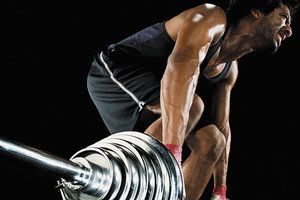Some doctors thrive in a personality-based clinic and have a loyal following no matter what services or equipment they offer, but for most chiropractic offices who are trying to grow and expand, new equipment purchases help us stay relevant and continue to service our client base in the best, most up-to-date manner possible. So, regarding equipment purchasing: should you lease, get a bank loan, or pay cash?
Weight Training: Are Cheat Reps Worth It?
While resting between exercises at the gym recently, a young lifter asked me for a spot on a set of barbell bench presses. The bar was loaded with a moderately heavy amount of weight that at first glance appeared to be too heavy for his frame. He began his set and immediately began bouncing the bar off his chest. As he progressed in reps and began struggling with the weight, he arched his back, thrusting his pelvis up and pushing his head into the bench. I just had to shake my head as he got up looking immensely satisfied with his set.
I get this question from my athletes often: When it comes to weightlifting, are "cheat" reps worth it? As a chiropractor, you're probably not surprised to know my short answer is "no." The long answer, however, is that not all cheating is created equal. Some of the world's best physiques, such as Ronnie Coleman's, were built utilizing momentum to help lift progressively heavier weights. On the other hand, bodybuilder Dorian Yates is religious about using perfect form on just about every exercise he does. Who's right?
Biomechanical Considerations
Biomechanically, several factors need to be considered. First let's differentiate between the two types of cheating in weightlifting. The more allowable of the two is the extended-set cheat, in which reps are performed with as perfect form as possible before using momentum or additional muscle groups to push past the point of failure for one or two reps.

If you've been training hard consistently for years and your progress has stalled, this is the type of cheating that can help push past a plateau. For everyone else, however, it's not necessary. Beginning and even moderately experienced weightlifters will build muscle without going to failure. They should be focused on perfecting form, not looking for ways to undermine it.
The other variety is the heavy cheat, in which a "looser" form is used through the entire set to lift heavier weight than normally possible. This is the type of cheating that should be discouraged for all lifters, no matter what their experience level or which exercises they're doing. The benefit gained is minimal compared to potential risk of injury.
The second consideration is injury history, as most cheating involves movements that are risky for joints, muscles and ligaments. For example, if you have a history of lumbopelvic injuries, it's not wise to be bouncing the bar off the pins while deadlifting. Even a slight slip in form can result in a serious injury if you're working with compromised joint and ligament function. The 6-8 months of lost time and lost progress spent recovering from an injury isn't worth the minimal extra muscle fiber activation.
The final consideration is the type of lift being performed, as certain exercises lend themselves to cheating reps better than others.
Allowable Cheat Exercises
- Lateral deltoid raises: Performing strict reps to failure and then swinging the weights slightly will hit your deltoids hard with little chance of injury.
- Dumbbell curls: Using some knee-bend and body English can extend the set past failure relatively safely.
- Triceps pushdowns: Use the lats and pecs to push past failure one or two reps.
- Seated leg press: Put your hands on your legs to get a few extra reps.
- Dumbbell / cable rows: Utilizing proper form until failure and then using momentum to keep going can be done with minimal injury risk.
- Lat pulldowns: It's difficult to injure yourself performing these, so cheating at the end of a set isn't usually a problem.
Asking for Injury: Cheat Exercises to Avoid
- Deadlifts
- Barbell rows
- Shoulder shrugs
- Bench presses
- Chest flyes
- Squats
- Leg curls
- Preacher curls
- Calf raises
- Upright rows
- Parallel bar dips
- Lying triceps extensions
- Chin-ups
Better Options to Maximize Gain
It's a shame that cheating is so overused, as there are better techniques for getting the maximum benefit out of a set. Drop sets, for example, are a great option for lifters looking for significant gains in mass. Drop sets are done by performing a lift to failure or just short of failure, then dropping the weight or resistance by about 15 percent and continuing repetitions. Once failure is reached again, an additional 15 percent of resistance is dropped, and so on. The idea behind forced sets, in which a spotter assists progressively more as your muscles fatigue, is similar.
If you're going to utilize extended-set cheaters, don't go overboard. Use strict form on the majority of sets and avoid cheating on any more than one or two sets per muscle group. Most weightlifters can make significant, consistent gains by using textbook form 100 percent of the time. As discussed above, there are some situations in which some extra "oomph" is needed to push through a plateau, but these are the exception, not the rule.
Cheat reps can be used with caution to add intensity on occasion if done at the end of sets and during the right exercises. Personal-injury history should also be considered. But as a general rule, listen to what your mother always said: cheaters never prosper.



